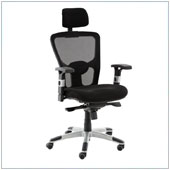 Regardless of the fast pace of technology or perhaps because of it, we are spending an ever increasing amount of time in the office, at our desks. While this has its upsides, with multi-functioning workspaces, there are downsides that could pose serious risks to not only your productivity but your health. In order to stave off potential health risks that come with sitting all day, it is a good idea to look into the ergonomics of your desk, and whether any improvements can be made. Regardless of the fast pace of technology or perhaps because of it, we are spending an ever increasing amount of time in the office, at our desks. While this has its upsides, with multi-functioning workspaces, there are downsides that could pose serious risks to not only your productivity but your health. In order to stave off potential health risks that come with sitting all day, it is a good idea to look into the ergonomics of your desk, and whether any improvements can be made.
Here are five ways you can make your desk more ergonomic:
1. Don’t use the keyboard feet
Many keyboards have feet at the top which can be used to move the top of the keyboard up. The reason for this isn’t actually for improved ergonomics, but to make the keys easier to see. If you type with two-fingers, this is effective, but if you are a touch typist, keeping the feet deployed could actually cause strain on your wrists. It’s best to keep the feet folded, and your keyboard as flat as possible.
2. Focus on the location of the B key
In order to reduce muscle, wrist and elbow strain, it’s important that you position your keyboard and mouse correctly. While you are sitting at your desk, you should make an effort to line up the B key with the center of the desk, or directly in front of you if you don’t sit at the center of your desk.
What this does is ensure that your wrists rest in a more natural, and comfortable position. You should also keep your mouse on the same level as the keyboard, and in close proximity. Basically you should move horizontally, not vertically.
3. Adjust the height of your seat and monitors
The height of your seat is vital as the ideal seat height will allow you to sit with your feet flat on the floor, and your arms are at the same height as the desk, or where your keyboard and mouse are.
While you are at it, you should also adjust the height of your monitor. While seated at your desk, you should be looking at the upper 2-3 inches of your monitor. If you find yourself looking at the bottom of the screen, it is a good idea to try and lower your monitor a little, or practice a better posture.
4. Practice good posture
When spending long hours at a desk, it can be tempting to slouch into your chair. While it definitely feels comfortable, it’s not the best for our bodies. The optimal posture is one where your feet are flat on the floor with your heels slightly in front of your kneecaps, back straight, with elbows close to your body and arms at the same height as the desk.
While sitting at your desk, it’s a good idea to maintain this posture, but relax your back and neck muscles. If they are tense, you are putting pressure on various nerves which could cause more problems. For example, the ulnar nerve, which is the main nerve of the arm, runs up through the neck. Having a tense neck could put strain on this and lead to increased chances of a repetitive strain injury.
5. Keep important things within reach
If you find yourself always reaching for something that is just out of your grasp, you could be putting undue strain on your body. You should take a step back and think about what you use the most, then move this within reach. This will reduce strain in the long run, and make you more efficient.
Having an ergonomic desk likely won’t make you noticeably massively more productive, but it will make you productive in the long run, because it can minimize the risk of injury which can take you away from your work. If you are looking into making your workspace more ergonomic-friendly, contact us today to see how we can help.
| 

 Regardless of the fast pace of technology or perhaps because of it, we are spending an ever increasing amount of time in the office, at our desks. While this has its upsides, with multi-functioning workspaces, there are downsides that could pose serious risks to not only your productivity but your health. In order to stave off potential health risks that come with sitting all day, it is a good idea to look into the ergonomics of your desk, and whether any improvements can be made.
Regardless of the fast pace of technology or perhaps because of it, we are spending an ever increasing amount of time in the office, at our desks. While this has its upsides, with multi-functioning workspaces, there are downsides that could pose serious risks to not only your productivity but your health. In order to stave off potential health risks that come with sitting all day, it is a good idea to look into the ergonomics of your desk, and whether any improvements can be made. As technology becomes ever more efficient and commonplace in the work environment, companies often look to upgrade existing systems which can be costly. In order to save costs, some businesses have been looking into virtualizing their technology. This complex idea could be beneficial for your company, but there are a number of terms used by professionals that may be confusing.
As technology becomes ever more efficient and commonplace in the work environment, companies often look to upgrade existing systems which can be costly. In order to save costs, some businesses have been looking into virtualizing their technology. This complex idea could be beneficial for your company, but there are a number of terms used by professionals that may be confusing. There are many tools that business owners and managers have at their disposal that enable them to do their jobs more effectively. One of the most important is the word processor, with the most popular being Microsoft Word. Word is favored because of the multitude of features available for users. There are many features that often go unused however, one being the ability to protect documents and set who can access and edit your documents.
There are many tools that business owners and managers have at their disposal that enable them to do their jobs more effectively. One of the most important is the word processor, with the most popular being Microsoft Word. Word is favored because of the multitude of features available for users. There are many features that often go unused however, one being the ability to protect documents and set who can access and edit your documents. A common misconception among many business owners and managers is that managing the security of their systems and computers is a time-consuming and costly endeavor. While it certainly can be expensive, how much you spend really depends on the type of security you want and need. In fact, there are security steps you can take that won’t cost you much in the way of time or money.
A common misconception among many business owners and managers is that managing the security of their systems and computers is a time-consuming and costly endeavor. While it certainly can be expensive, how much you spend really depends on the type of security you want and need. In fact, there are security steps you can take that won’t cost you much in the way of time or money. One common threat to businesses is disaster. One can strike at any time and can vary in severity. Regardless of whether a company is facing a major catastrophe or something as simple as spilling water on a keyboard, it is a good idea to take steps to prepare for different potential disaster scenarios. A way to prepare for disaster is to back up your data using backup solution, such as one off site.
One common threat to businesses is disaster. One can strike at any time and can vary in severity. Regardless of whether a company is facing a major catastrophe or something as simple as spilling water on a keyboard, it is a good idea to take steps to prepare for different potential disaster scenarios. A way to prepare for disaster is to back up your data using backup solution, such as one off site.